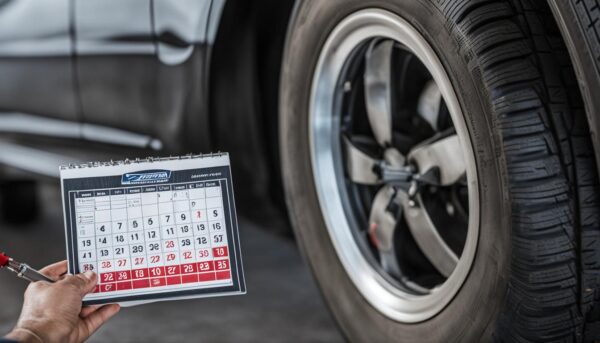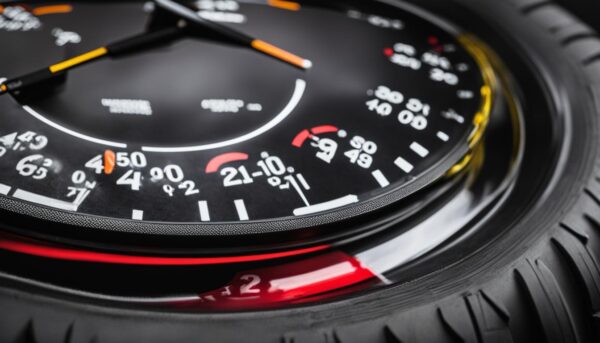Last Updated on 4 months
Learn How to Check Tires Effectively Before Buying
Your vehicle’s safety and performance heavily rely on its tires. Before buying new tires, it’s essential to understand how to check tires and ensure you’re making the right decision. This article will provide a comprehensive tire inspection guide, safety check, and unbeatable tire maintenance tips. So, let’s dive right into the three crucial aspects before purchasing your next set of tires.
Key Takeaways
- Inspect the tire sidewall for damage, which could lead to unexpected tire failure.
- Always measure tread depth for safety and ensure it’s above 2/32nds of an inch.
- Choose the right tire type based on your regional climate and driving conditions.
- Perform regular tire pressure checks to maintain optimal performance
- Follow a tire maintenance schedule for peak vehicle safety and tire longevity
Understanding the Fundamentals of Tire Inspection
Tire condition directly impacts vehicle safety and performance. Regularly inspecting tires for damage and wear is essential in preventative maintenance. Sidewall damage, such as abrasions, cracks, or bulges, can lead to hazardous tire failures, while even minor damage warrants closer examination by a professional.
The Critical Role of Tire Condition in Safety and Performance
Proper tire maintenance is crucial for ensuring top vehicle performance, preserving fuel efficiency, and providing a comfortable driving experience. A vehicle’s tire condition dramatically affects the overall safety on the road and the life of the tire itself. Regular tire inspections help identify any tire issues, allowing for timely repairs or replacements to prevent unforeseen problems.
Mastering the Basics of How to Check Tires
To become proficient at tire checks, it’s essential to:
- Inspect your tire’s sidewall for damage, such as abrasions, cracks, or bulges.
- Verify that the tread depth exceeds the minimum safety standard of 2/32nds of an inch.
- Ensure that tires are suited for the driving conditions they will face.
- Check the tire type for regional weather compatibility, looking at tire markings and tread patterns.
Tread depth can be measured using simple tools like a penny, and uneven wear may indicate mechanical issues.
Recognizing the Warning Signs of Tire Wear and Damage
Identifying tire wear and damage involves checking for:
- Chunks larger than a dime are missing from the tire.
- Exposed textile cords.
- Sidewall lumps indicate broken cables.
- Treadwear patterns.
Deeply worn treads, smooth areas, or exposed cords necessitate immediate tire replacement. By following a comprehensive tire inspection guide and adhering to tire maintenance guidelines, you can maximize the life of your tires and ensure road safety for yourself and others.
Evaluating Sidewall Integrity for Effective Tire Maintenance
Tire sidewall inspection is crucial to maintaining your tires’ overall health. To ensure your safety on the road, monitoring the sidewall integrity helps identify potential issues that may compromise your tires’ structural integrity. Here are some tire maintenance tips to help you stay informed about the state of your tire sidewalls:
- Inspect the sidewall regularly for visible damage, such as deep abrasions, missing chunks, or sidewall bulges.
- Please pay special attention to areas near the edge of the rim, as they can be susceptible to damage from potholes and road debris.
- Stay vigilant for unusual bulges or deformities, which could indicate severe internal damage to the tire cords.
Regular tire maintenance, including sidewall inspections, is essential for the longevity and performance of your tires.
“Maintaining the integrity of your tire sidewalls helps ensure a safe and comfortable ride, while also prolonging the life of your tires. Inspecting your tires regularly can help catch potential problems early, before they lead to a dangerous tire failure on the road.”
When conducting a tire sidewall inspection, it is essential to recognize that certain elements indicate broken tire cords, warranting a professional assessment. Here are some tell-tale signs of potential sidewall issues:
- Deep abrasions can be signs of embedded debris or contact with a sharp object. If left unchecked, they can weaken the tire cords and lead to tire failure.
- Chunks missing: Any significant portion of rubber missing from the sidewall may expose the tire cords and compromise the overall strength of your tire.
- Sidewall bulges: If you notice a lump or blister on your tire sidewall, this could signal internal damage or broken cords. It’s essential to have a professional examine the tire immediately, as driving on a damaged tire can lead to a dangerous blowout.
By diligently performing tire sidewall inspections and following these tire maintenance tips, you can effectively maintain the sidewall integrity of your tires and ensure a safe driving experience.
Decoding the Tread Depth Mystery: When to Replace Your Tires
Performing a tread depth check is crucial in any comprehensive tire inspection guide. Measuring and interpreting tread depth is essential for maintaining tread depth safety and recognizing tire replacement indicators. Continue reading to learn how to measure tread depth using simple tools and how to interpret tread wear patterns for a thorough tire assessment.
Using Simple Tools to Measure Tread Depth
An ordinary penny is an easy and inexpensive approach to measuring tread depth. By placing the coin in the tire grooves, you can quickly determine if your tires are approaching the need for replacement. To check the tread depth, follow these steps:
- Find a penny and place it between the tire’s tread grooves.
- Ensure that President Lincoln’s head is facing down and towards the tire.
- Inspect Lincoln’s head visibility. If the top of his head is obvious, the tread depth is below the recommended 2/32nds of an inch.
- This indicates that your tire has reached its wear limit, and it’s time to start considering tire replacement.
The penny test should be performed on multiple tread grooves and locations on each tire to ensure accuracy.
Interpreting Tread Wear Patterns and What They Tell You
An often overlooked aspect of tire maintenance is identifying and understanding tread wear patterns. Analyzing tread wear patterns can provide crucial insights into other issues affecting your vehicle. Here are some common tread wear patterns and what they may indicate:
- Center Wear: Occurs when the center of the tire wears quickly than the edges, often due to overinflation.
- Edge Wear: Indicates that the tire’s edges deteriorate faster than the center, usually because of underinflation.
- One-sided Wear: Uneven wear on one side of the tire can indicate poor wheel alignment or worn suspension components.
- Cupping Wear: A sequence of raised and lowered tread sections, suggesting vehicle suspension problems or tire imbalance.
If you notice any of these uneven tread wear patterns, it is essential to consult a mechanic for a thorough evaluation of your vehicle’s suspension and alignment.
Conducting a tread depth check regularly and interpreting tread wear patterns will help you recognize tire replacement indicators. Incorporating these methods into your tire inspection routine ensures your vehicle remains safe and dependable on the road.
Pressure Points: Checking Tire Pressure Correctly
Correct tire pressure is paramount for vehicle safety, fuel efficiency, and preventing premature tire wear. A reliable tire gauge to check and maintain the pressure at the recommended levels indicated by the vehicle manufacturer is essential for optimal performance. This section will discuss the importance of checking tire pressure and provide a simple tire maintenance checklist to help ensure your tires are always in top-notch condition.
Remember that regular tire pressure checks are crucial for keeping your tires in good condition and ensuring safe driving conditions.
Why is checking tire pressure necessary? There are three main reasons:
- Vehicle Safety: Proper tire pressure helps maintain good traction on the road, which is critical for safe driving.
- Fuel Efficiency: Underinflated tires can lower your vehicle’s gas mileage, leading to higher fuel costs. On the other hand, overinflated tires can cause uneven tire wear and reduce fuel efficiency.
- Preventing Premature Tire Wear: Incorrect tire pressure can lead to uneven tread wear, reducing the lifespan of your tires and resulting in the need for replacements more often.
When should you check your tire pressure? As a general guideline, it’s a good idea to check it at least once a month and before long trips. You should also check it when there’s a significant temperature change, as cold weather can cause tire pressure to drop.
Tire Maintenance Checklist
To help you stay on top of your tire maintenance, follow this simple checklist:
- Check tire pressure monthly and adjust according to the vehicle manufacturer’s recommendations.
- Inspect tires for signs of wear, damage, or uneven tread wear.
- Rotate tires every 5,000 to 8,000 miles or as the vehicle manufacturer recommends.
- Balance tires and check alignment if you notice irregular tread wear patterns.
- Replace tires when the tread depth reaches 2/32nds of an inch, which indicates they are worn out and cannot provide optimal traction on the road.
By adhering to this tire maintenance checklist, you can ensure your tires are always in good condition and help prevent potential issues related to incorrect tire pressure and uneven wear. Remember, proper tire maintenance is integral to vehicle safety and optimal performance. Happy driving!
Tire Types and Climate Compatibility
Choosing the right tire type for your vehicle depends on multiple factors, including regional climate conditions and the expected driving environment. Understanding the critical differences between all-season, summer, and winter tires allows you to make informed decisions that improve road safety and overall tire longevity.
The Differences Between All-Season, Summer, and Winter Tires
- All-season tires are designed to provide adequate traction in wet, dry, and mildly snowy conditions. Their moderate tread depths make them a versatile choice when you don’t regularly encounter extreme snow or high summer temperatures.
- Summer tires perform exceptionally well in warmer weather, providing excellent grip on wet and dry surfaces. Their tread patterns and compounds are designed for optimal road contact, but lose these advantages in cold temperatures.
- Winter tires, identifiable by a snowflake symbol, are specifically engineered for cold weather and icy or snowy road conditions. They use distinctive tread patterns and flexible compounds to maintain grip and control in cold temperatures. However, driving with winter tires in warm temperatures can cause accelerated wear.
Selecting the Right Tire for Your Regional Weather Conditions
- Assess your region’s climate patterns, considering summer and winter conditions.
- Choose all-season tires if you experience moderately varying climates with rare extremes.
- Opt for summer tires if your region has consistently warm temperatures and minimal snowfall.
- Select winter tires if you live in an area with harsh winter conditions, including cold temperatures, ice, and heavy snowfall.
By understanding the differences between all-season, summer, and winter tires and the climate compatibility of each type, you can confidently choose tires that improve safety and longevity in your region’s distinct weather conditions. Proper tire choice based on regional climate is essential for responsible vehicle maintenance and optimal driving performance.
The Importance of Tire Maintenance Timing

Adhering to a regular tire maintenance schedule ensures your vehicle’s safety and performance. Consistent inspection of essential factors, such as tread depth, tire pressure, and sidewall conditions, can prevent unforeseen failures and prolong tire life.
Manufacturers and experts often recommend checking your vehicle’s tires at least once a month. However, many drivers may wonder how to determine the appropriate tire maintenance timing. This section will discuss how often to check tires and provide general tire maintenance guidelines to help you keep your vehicle running safely and efficiently.
| Tire Maintenance Task | Recommended Frequency |
|---|---|
| Visual inspection for damage and wear | At least once a month and before long trips |
| Checking tire pressure | At least once a month and before long trips |
| Measuring tread depth | At least once every three months or 3,000 miles |
| Tire rotation | Every 5,000 to 8,000 miles or as recommended by the manufacturer |
| Wheel alignment | Every 12,000 to 15,000 miles or as recommended by the manufacturer |
“Maintenance is the key to preventing tire-related incidents.” – National Highway Traffic Safety Administration
While these guidelines provide a general framework, you should always consult your vehicle’s owner’s manual for specific recommendations based on your car’s make and model. Additionally, if you notice any unusual wear patterns or experience issues with handling or tire performance, it’s best to have a qualified professional assess the situation immediately.
- Visual inspections: Check the tread and sidewall of your tires for signs of wear and damage, such as cracks, punctures, bulges, or cuts.
- Checking tire pressure: Use a reliable tire gauge to measure and maintain the appropriate pressure level as your vehicle’s manufacturer recommends.
- Measuring tread depth: Ensure that your tires have adequate tread depth for safe driving and replace them when the depth falls below the minimum safety standard of 2/32nds of an inch.
- Tire rotation: Regularly rotating your tires can help prolong their lifespan by allowing more even tread wear across all four tires.
- Wheel alignment: Keeping your wheels aligned can ensure proper tire wear and improved vehicle handling, ultimately preventing premature tire replacement.
In conclusion, understanding the importance of tire maintenance timing plays a critical role in safeguarding your vehicle’s performance and safety. By adhering to the recommended guidelines and promptly addressing any issues that may arise, you can extend the life of your tires and enjoy a smoother and safer driving experience.
Tire Maintenance Checklist: Preparing for the Long Haul
Preparing your tires for long-term performance is essential before embarking on any significant journey. This ensures optimal safety and vehicle efficiency during your travels. A comprehensive tire maintenance checklist will help maintain the best possible condition for your tires and provide a smoother, safer driving experience. Below, we’ve assembled an easy-to-follow tire maintenance checklist for your convenience.
- Regular pressure checks: Monitor and maintain correct tire pressure according to the manufacturer’s recommendations.
- Tread depth measurement: Periodically assess the tread depth to ensure it exceeds the 2/32nds of an inch safety standard.
- Visual inspection for wear: Inspect the overall state of the tire, including uneven tread patterns and suspicious wear signs.
- Visual inspection for damage: Examine the tire’s sidewalls for any sign of abrasions, cracks, or bulges that could indicate internal damage.
- Verify tire type: Ensure you have the correct tire type for your driving conditions and geographical region.
- Wheel alignment: Check for any misalignment leading to uneven tire wear and decreased fuel efficiency.
- Tire rotation: Rotate tires as the manufacturer recommends to promote even tread wear and prolong tire lifespan.
- Inspect the spare tire: Don’t forget to inspect your spare tire’s condition and maintain appropriate pressure levels.
This tire maintenance checklist can prepare your tires effectively for any long journey. Remember, a well-maintained set of tires is essential for optimal safety, performance, and fuel efficiency. So, before hitting the road, use this tire inspection guide to prepare your tires for travel, ensuring peace of mind and a smoother ride.
Essential Tire Maintenance Tips for Prolonged Tire Life

Routine tire inspections can extend tire durability and uncover potential issues before they worsen. Regular checks for correct tire pressure, tread wear, and sidewall damage are critical in avoiding premature replacement. In this section, we’ll discuss the importance of routine inspections and when it’s best to seek professional tire help for optimal tire maintenance.
How Routine Inspections Extend Tire Durability
Routine tire inspections play a pivotal role in maintaining the durability and longevity of your tires. By performing regular check-ups, you can:
- Monitor tire pressure and adjust as needed to prevent overinflation or underinflation
- Identify uneven tread wear and respond accordingly to avoid premature tire replacement
- Discover minor or hidden sidewall damage before a catastrophic tire failure
- Prevent blowouts and extend the tire’s lifespan
A consistent tire maintenance routine ensures your tires remain in top shape, saving time and money.
Quick Fixes vs. Professional Help: When to Seek Expert Advice
While some tire issues can be quickly fixed at home, others require the expertise of a professional. Knowing when to seek tire repair advice and when to opt for a DIY approach is essential. Below are some examples:
| Quick Fixes | Professional Help |
|---|---|
| Adjusting tire pressure | Abnormal wear patterns |
| Removing debris from tire grooves | Extensive sidewall damage |
| Checking and tightening lug nuts | Exposed thread cords |
Routine tire inspections help you identify and distinguish between minor fixes and situations requiring professional assistance. By keeping a close eye on your tires’ condition and understanding when to seek help, you’ll ensure your vehicle’s safety on the road and prolong the life of your tires.
Maximizing Safety: The Importance of Regular Tire Inspections
Regular tire inspections are critical to maximizing safety on the road. Consistent checks can identify underinflation, tread wear, or damage, allowing for timely corrections and ensuring a safe driving experience. By understanding the importance of tire inspection and performing regular tire checks, you can significantly reduce the risk of accidents caused by tire failures and maintain optimal vehicle performance.
Regular tire inspections help you stay informed about your tires’ condition, particularly detecting early warning signs of potential problems. By addressing these concerns promptly, you can prevent costly repairs or replacements, extend the life of your tires, and ensure a safe driving experience.
- Check tire pressure regularly to maintain optimal levels according to the vehicle manufacturer’s recommendations.
- Inspect tire tread depth to ensure it exceeds the minimum safety standard of 2/32nds of an inch.
- Examine the sidewalls and the entire surface of the tire for any visible signs of wear or damage, such as cuts, punctures, bulges, or cracks.
- Assess the tire’s overall condition and performance, looking for uneven wear patterns that may indicate alignment or suspension issues.
- Rotate tires as needed and ensure they are correctly balanced and aligned for optimal performance.
Tire inspections are an essential aspect of vehicle maintenance, increasing safety on the road and prolonging the life of your tires.
| Element to Inspect | Recommended Inspection Frequency |
|---|---|
| Tire Pressure | At least once a month |
| Tread Depth | Every 3,000-6,000 miles or as needed |
| Sidewall and Surface Condition | Every time you check the tire pressure |
| Alignment and Balance | Every 6,000-8,000 miles, or sooner if you notice uneven wear or poor handling |
| Tire Rotation | Every 5,000-8,000 miles, or as recommended by the vehicle manufacturer |
In conclusion, tire safety is vital for ensuring a secure and comfortable driving experience. Incorporating regular tire inspections into your car maintenance routine gives you peace of mind and helps avoid unexpected issues or accidents caused by inadequate tire conditions. Keep your vehicle in top shape by prioritizing the importance of tire inspection and regularly checking each aspect of your tires.
Conclusion
Recognizing the importance of tire inspection and understanding how to check tires correctly is crucial for ensuring vehicle safety, performance, and tire longevity. By developing a solid grasp on the essential aspects of tire maintenance, drivers can avoid potential road hazards and prolong the life of their tires.
Regular inspections are crucial in proper tire management. They allow you to identify incorrect tread depth, sidewall damage, or pressure irregularities. By addressing these issues promptly, you can maintain optimal tire performance and ensure a safe driving experience.
Lastly, selecting the correct tire type is central to a vehicle’s ability to effectively handle various climates and road conditions. Adhering to recommended maintenance guidelines and tire type considerations can maximize safety, performance, and tire life for the long haul. So, before hitting the road, don’t forget to prioritize tire maintenance.
FAQ
What are the basic steps in checking tires before purchasing?
Inspect the sidewall for damage, such as missing chunks of rubber, abrasions, and bulges. Measure the tread depth to ensure it is above 2/32nds of an inch, and ensure the tire type is appropriate for the climate and driving conditions you will face.
How do I recognize warning signs of tire wear and damage?
Look for missing chunks from the tire that are more significant than a dime, exposed textile cords, sidewall lumps indicating broken lines, and unusual tread wear patterns. Deeply worn treads, smooth areas, or exposed cables necessitate immediate tire replacement.
How can I measure tread depth using a penny?
Insert the penny into the tire grooves with Lincoln’s head facing down. If the top of his head is visible, the tread depth is below the recommended 2/32nds of an inch, indicating a need for tire replacement.
What are the differences between all-season, summer, and winter tires?
All-season tires balance wet, dry, and mild snow traction. Summer tires excel in warm, wet, and dry conditions but perform poorly in cold weather. Winter tires, marked with a snowflake symbol, provide superior grip in ice and snow but wear quickly in warm conditions.
How often should I check my tires for maintenance?
Manufacturers and experts often recommend checking your vehicle’s tires at least once a month for optimal safety and performance.
What should I include in my tire maintenance checklist?
Include regular pressure checks, tread depth measurements, and visual inspections for wear and damage. Stick to a routine to maintain the best tire condition and safety.
When should I seek professional help for tire maintenance?
Seek professional help for abnormal wear patterns, extensive sidewall damage, or exposed tread cords. Tire professionals must be experts in these issues to ensure proper repair and safety.
Source Links









